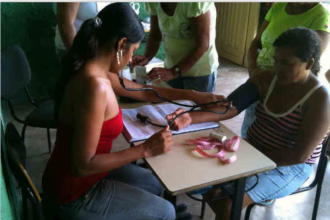Despite declines in average fertility rates worldwide, an estimated 14 to 16 million children are born to women aged 15 to 19 each year. Over half of women in sub-Saharan Africa give birth before age 20. As I’ve blogged previously, many of these births take place in the context of early marriage. Approximately half of girls in sub-Saharan Africa are married by age 18, while 73% of girls are married by that same age in Bangladesh.
Despite declines in average fertility rates worldwide, an estimated 14 to 16 million children are born to women aged 15 to 19 each year. Over half of women in sub-Saharan Africa give birth before age 20. As I’ve blogged previously, many of these births take place in the context of early marriage. Approximately half of girls in sub-Saharan Africa are married by age 18, while 73% of girls are married by that same age in Bangladesh.
Pregnancy poses a substantial health risk for adolescents. The World Health Organization reports that health problems associated with adolescent pregnancy include increased maternal and neonatal mortality and increased incidence of preterm or low birth weight, among many other adverse health conditions. A study from the British Medical Journal found that complications from pregnancy and childbirth were the leading causes of death for young women between the ages of 15-19 in developing countries.
Yet beyond the health and rights consequences of teenage fertility, little work has systematized the extent of the non-health adverse effects associated with adolescent fertility and the effectiveness of the interventions used to date to reduce teenage fertility in low- and middle-income countries. In a new paper, Kate McQueston, Rachel Silverman and I aim to fill this gap.
First, we explore trends between adolescent childbearing and socioeconomic outcomes. While the review finds strong correlations between adolescent fertility and school drop-out, the question of causation remains far more ambiguous, as effect sizes decrease sharply with more rigorous research methods. Moreover, the study also finds that in some contexts, high numbers of women continue education after child birth—suggesting that childbirth and education (and other related outcomes) may not be incompatible.
Similarly, the review of interventions to reduce adolescent fertility finds variation across studies, but also notes some general findings. The evidence base for conditional cash transfers, though somewhat variable, is by far the most robust when compared to the other interventions. Additionally, programs that lowered barriers to attending school or increased the opportunity costs of not attending school were also found to be effective—suggesting that education may substitute for adolescent fertility. Notably, the most effective interventions appeared to be outside of the typical reproductive health sphere.
The paper is limited by the quality and scope of the studies available. Further, adolescent fertility and its causes are complex, nuanced issues that are affected by a range of motivations and external factors. Nonetheless, this research reframes the conversation about adolescent fertility and the policies and interventions that might be used to reduce its frequency.
Among other findings, we suggest that adolescent fertility is more consequence than cause of socioeconomic disadvantage. While fertility is often correlated with school dropout, other factors – current school enrollment, marital status, anticipated economic returns to education, family attitudes, and other related context — drive both school continuation and the likelihood of experiencing an adolescent pregnancy. This finding suggests that a more holistic (and possibly complex) approach may be needed to address the foundational causes of adolescent fertility. Creating economic opportunities for women, reducing adolescent marriage, and changing gender norms are likely to be more effective in the quest to accelerate economic development than merely reducing adolescent fertility.
While interventions that focused on increasing knowledge and changing attitudes about sexual and reproductive health appeared successful in the short term, there was little evidence of any long term impact. On the contrary, interventions that encouraged school attendance proved more effective in reducing overall adolescent fertility. This evidence suggests that policymakers should expand educational opportunities for girls and create incentives for school continuation, such as conditional cash payments or the expectation of a worthwhile job following graduation. Reproductive health services are important for many young women, but increasing contraceptive access and uptake may not, on its own, be sufficient to change fertility trends.
As the world prepares for the upcoming family planning summit, it is worth pausing to examine the findings of the growing experimental literature on programs that aim to reduce teen pregnancy and to consider a broader and synergistic approach.






